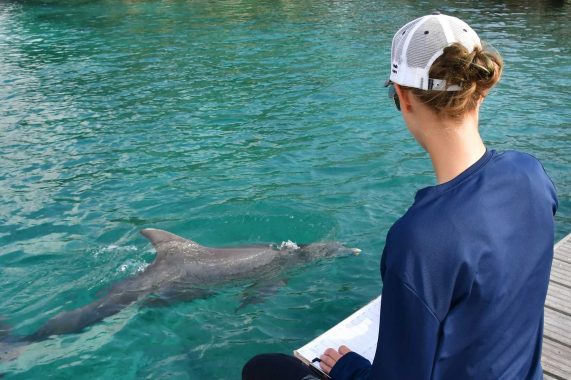Dolphin Research
Learn about our corroborative research efforts to expand and enhance our understanding of dolphins and their habitats.



Electroencephalogram measurements for brain activity in resting dolphins
Dolphins have evolved a unique method of mental rest, namely unihemispheric “sleep.” Past studies have shown that dolphins have the capability to rest one hemisphere of the brain while the other half remains awake and active. Dolphin Academy has reproduced this testing in order to provide a baseline data set for its particular dolphin population in order to embark on a multi-year study of: rest/wake dolphin cycles from birth to maturity, sensory responsiveness of resting dolphins, time-place association in dolphins, dolphin hormone sampling, and measurement using saliva and blow-hole chuffs.
Multi-year sleep research
Beginning in January 2013, DA/UG initiated the “sleep-like resting behavior” research project, which consists of non-invasive around the clock observations of the dolphins. Every year, at the end of the rainy season (end of February, beginning of March), researchers observe the dolphins during multiple time-periods, eventually leading to a full 24/7 image of their daily patterns. The research shows interesting findings of the way the dolphins spend their days and nights. We now know how much time each dolphin prefers to sleep, the location they prefer, and with which individuals dolphins prefer to associate.
The project is on-going, collecting more data every year and forming a life-long dataset of the (changing and evolving) daily rhythms of this dolphin community. This data set includes: how infant dolphins allocate their time immediately after giving birth, how they spend their days and nights while transitioning into semi-independent calves, their activity range as they grow to adolescence, and the contributing factors that shape their daily rhythm when they become adults.
Over time, researchers can combine the data of different age-groups through the years and watch for trends in rhythmic variation, the differences between males and females, and how being a full-time mother influences a dolphin’s rest/wake patterns.


Mother-calf behavior
A principle focus of the long-term sleep study is the development of rest/wake behavior in the pre and post-partum periods for mother dolphins and their new-born calves. Due to the fact that dolphins are one of the only mammalian species on earth that remain in constant movement after birth, calves tend to sleep very little in the first days and even weeks after birth, (it is questionable if they “sleep” at all). With nearly all mammals, babies tend to sleep most of the day. With dolphins, however, it is quite the opposite, the amount of sleep they get increases with age. This is contrary to humans, for example, who sleep less and less as age increases. With every new birth, we increase our knowledge of this subject.
Sensory responsiveness of resting dolphins
One important criterion that has never been investigated in resting Bottlenose dolphins is whether they have an increased arousal threshold. This is also known as a decreased sensory responsiveness, which basically means that the deeper you sleep, the harder it is to wake you up. Usually, humans go through different sleep stages/depths. In the more shallow stages, a person will be woken by any little noise, whereas in deeper stages the same person will be almost impossible to awaken.
However, as dolphins always have a part of their brain awake and active, does this mean that they do not have an increased arousal threshold? Do they respond the same way when resting, as when they are fully awake? While this would be an obvious advantage when sleeping in a possibly unsafe and ever-changing environment, it would seem that a certain amount and depth of sleep is necessary to function properly. DA/UG is currently in the last stages of testing the arousal threshold using different frequencies and volumes of sounds, broadcast through an underwater speaker while dolphins exhibit resting behavior.


Time-place association/reward anticipatory behavior
Having a circadian rhythm implies that certain behaviors only occur at certain moments of the day. To establish the presence of a circadian clock, which is the base of any circadian rhythm, we have and are testing the dolphins’ anticipatory behavior using a food-based reward at certain locations at certain times. If there is a working circadian clock present in Bottlenose dolphins, they should be able to anticipate these predictable events and thus show anticipatory activity before the scheduled feedings. In order to test this, we have set up a time-place association test. Preliminary results indicate a difference between males and females, and more specifically, females with calves. However, it has only been tested on a few dolphins with varying results, so more tests are needed.

